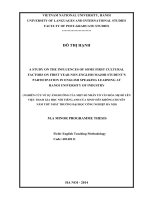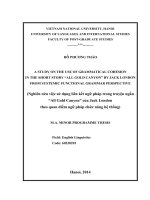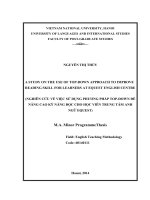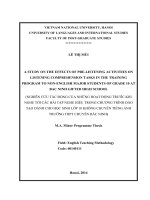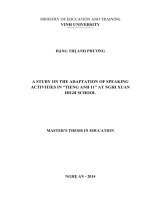A study on the assessment of patterns and complication of foreign body a spiration amon children visted pediatrics emergency room of tikur anbessa specialized hospital,addis ababa ethiopia
Bạn đang xem bản rút gọn của tài liệu. Xem và tải ngay bản đầy đủ của tài liệu tại đây (812.65 KB, 42 trang )
A Study on the Assessment of Patterns And Complication of Foreign
Body Aspiration Among Children Visited Pediatrics Emergency Room of
Tikur Anbessa Specialized Hospital, Addis Ababa.Ethiopia.
Research thesis Submitted to Addis Ababa University, College of Health
Sciences,Department of Emergency Medicine for Partial Fulfillment of
the Requirements for Master of Science Degree in Emergency Medicine
and Critical Care Nursing
Principal investigator:
Advisors:
Addisu Tamalew (Bsc)
Kibatu Gebre (Bsc,BA, Msc)
Dr Tigist Zewdu (ER Physician, Assistant Professor
June, 2017,
Addis Ababa- Ethiopia
ACKNOWLEDGEMENT
First of all, I would like to thank God with his immaculate mother. Next, heartfelt gratitude goes
to Addis Ababa University who provides the opportunity to conduct this research. Besides, my
gratitude also goes to my advisors Mrs. Kibatu Gebrie (Bsc, BA, Msc) and Dr Tigist Zewdu for
their unreserved help, comment, supervision and provision of necessary materials from the
beginning of title selection till thesis completion.
i
TABLE OF CONTENTS
Contents
Pages
ACKNOWLEDGEMENT .....................................................................................................................i
TABLE OF CONTENTS ...................................................................................................................... ii
LIST OF ACRONYMS ....................................................................................................................... iv
ABSTRACT .......................................................................................................................................v
Introduction.....................................................................................................................................v
1.
INTRODUCTION ........................................................................................................................1
1.1.
Background..........................................................................................................................1
1.2.
Statement of the Problem: ......................................................................................................4
1.3.
Significance of the study: .......................................................................................................5
2.
LITERAT URE REVIEW...............................................................................................................6
3.
OBJECTIVES ..............................................................................................................................9
4.
3.1.
General objectives .................................................................................................................9
3.2.
Specific objectives ................................................................................................................9
MET HODOLOGY ..................................................................................................................... 10
4.1.
Study area and period: ......................................................................................................... 10
4.2 Study design:............................................................................................................................ 10
4.3 Population ............................................................................................................................... 10
4.3.1 Source population ............................................................................................................... 10
4.3.2 Study population................................................................................................................. 11
4.4 Eligibility criteria:..................................................................................................................... 11
4.4.1 Inclusion criteria:................................................................................................................ 11
4.4.2 Exclusion criteria:............................................................................................................... 11
4.5 Sample size calculation and sampling procedures.......................................................................... 11
ii
4.6 Sample size determination ......................................................................................................... 11
4.7 Sampling procedures:................................................................................................................ 11
4.8 Data collection tools and techniques ............................................................................................ 12
4.9 Study variables ......................................................................................................................... 12
4.9.1 Dependent variable: ............................................................................................................ 12
4.9.2 Independent variable: .......................................................................................................... 12
4.10 Operational definition .............................................................................................................. 12
4.11 Data quality assurance ............................................................................................................. 13
4.12 Data analysis procedure ........................................................................................................... 13
4.13 Ethical considerations .............................................................................................................. 13
4.14 Dissemination of the results...................................................................................................... 13
5.
RESULT ................................................................................................................................... 14
5.1. Socio – Demographic characteristics .......................................................................................... 14
6.
DISCUSSION............................................................................................................................ 22
6.1 CHALLENGES AND LIMITATION OF THE STUDY ................................................................. 24
7. CONCULUTION AND RECOMENDATION.................................................................................... 26
7.1 CONCLUSION ........................................................................................................................ 26
7.2 RECOMENDATION............................................................................................................... 26
8. REFERENCES ............................................................................................................................ 27
ANNEXES ....................................................................................................................................... 30
Annex 1: Questionnaire/Check list ................................................................................................... 30
Annex 2: Assurance of the investigator ............................................................................................. 30
Annexes ........................................................................................................................................... 30
QUESTIONNAIRS ........................................................................................................................ 30
iii
LIST OF ACRONYMS
AAU-------------------Addis Ababa University
DC----------------------Data Collection
ECSA-------------------Ethiopian Central Statistical Agency
EDHS-------------------Ethiopian Demographic Health Survey
FBA---------------------Foreign body aspiration
NGO-------------------- Non Governmental Organizations
PED---------------------Pediatrics Emergency Department
PI------------------------principal Investigator
Yrs----------------------Years
WHO-------------------World Health Organization
iv
ABSTRACT
Introduction: Foreign body (FB) aspiration is the act of accidentally inhaling a foreign body,
usually materials, food or drink. It is the leading cause of death all parts of the world. Foreign
body (FB) aspirations in childhood are frequently emergency conditions especially in less than 3
years age, comprising an important proportion of accidental deaths one of the leading causes of
death young children that almost 600 children under 15 years of age die per year in the USA
Objectives: This study aims to determine the patterns of foreign body aspiration among children
at
Tikuer
Anebsa
Specialized
Hospital
Pediatric
Methods: All patients with FB aspiration treated at Tikuer Anebsa
Emergency
Department.
specialized hospital in the
department of pediatric emergency OPD over a period o f three year from January 2014 to
Decmber2016.were.retrospectively.reviewed.
Result :-From the total 5412 surgery patients who visited the pediatric emergency department of
TASH during the study period,289 (5.3%) were foreign body aspiration patients. From secondery
data showed Out of the 289 cases 150 cards having complet information about pattern and
complication of FB. Among the participants
95 (63.3%)were males and 55 (36.7%) were
females, giving a male to female ratio of 1.7:1. The patients’ mean ages 59.05 months(5 years)
with the ranged of 6 months to 13 years. 41(27.3%) of the victims were between 12-36 months
( 1-3years). The most common cause of foreign body aspiration is crops / seeds accounted
54(36.0%) from these bean is common. Plastic and metallic materials high in frequency of
foreign body aspiration accounted 44(29.3%) & 28(18.7%) respectively.Almost all of the
patients 149(99.3%) have sudden onset of cough, 84(56%) and 25(16.7%) of the patients have
sudden onset of difficulty in breathing and vomiting respectively. Most of the patients 71 (47.3%)
have high grade fever. 52(34.7%) and 43(28.7%) of cases have lodgment on the right main
v
bronchus
and trachea respectively. The average time of arrival to hospital is 17.6 days and
ranged from 1 hour to 360 days. The majority of patients 61(40.7%) arrived to hospital
after aspiration is within 3-7 days. Only 21(14%) of patients arrived with in 24 hours. 68(46% )
of FBA patients developed complications. From these 44(64.7%) were aspiration pneumonia.
139(92.7%) of cases were managed with surgical procedure. Bronchoscopy was done for most
of the cases 140(93.3%) . The average length of stay was 7(6.7) days
days.
Keywords;-Foreign body aspiration, children, pattern, Ethiopia
vi
ranged from 1 day to 61
1. INTRODUCTION
1.1.
Background
Foreign body (FB) aspiration is the act of accidentally inhaling a foreign body, usually materials,
food or drink1 . Foreign body (FB) aspirations in childhood are frequently emergency conditions
especially in less than 3 years age, comprising an important proportion of accidental deaths one
of the leading causes of death young children; for example, FB aspiration has been responsible
for more than 300 deaths per year in the USA. It most commonly occurs in the 1-3 year-old age
group, tending to occur in boys more than girls. Children of this age are prone to foreign body
aspiration because they: put objects in their mouths (particularly while running) and have less
ability to chew food in the absence of molar teeth2, 3, 4, 5 .
The majority of aspirated objects are organic in nature, mainly food. Peanuts are the cause most
commonly identified by different authors, but some mention melon and sunflower seeds as the
predominant causes1, 6, 7, 8 . Surprisingly, however, plastic toys are not a frequent cause of FBA in
series from developing countries but they represent more than 10% of those identified in the
developed world
2, 3,4,12
.
Children are notoriously fond of putting objects into various orifices either on their own or partly
as a result of oral phase of psychological development and partly due to innocence. Accidental
foreign body aspiration (FBA) is a relatively common occurrence in the pediatric population and
may lead to asphyxiation and death. Among the pediatric patients, children between the ages of
12-48 months have been found to be the major victims owing to their poor chewing ability
because of the lack of posterior dentition, a tendency to put things into mouth, and a tendency to
have frequent vigorous, uninhibited inspirations when startled, laughing or coughing
1
6,7
.
Foreign body aspiration manifests with a wide range of clinical presentations and often these are
not accompanied by any reliable witness to supply clinical history especially in children. The
degree of difficulty will depend on a number of factors: the age of the patient, the type of foreign
body inhaled the interval between inhalation and removal. The peak incidence of inhalation of
foreign bodies in early childhood is of course related to the fact that children have a habit of
putting objects into their mouths to determine their texture and taste, and to chew on when
teething
22,23
.
The symptoms and signs produced depend upon the nature, size, location and time since the
lodgment of the foreign body in the trachea-bronchial tree. The main symptoms associated with
foreign body aspiration are suffocation, cough, stupor, excessive sputum production, cyanosis or
difficulty in breathing, choking and tachypnea. These symptoms develop immediately after the
aspiration but many a times these features are not correlated to an episode of aspiration of a
foreign body and thus the diagnosis is escaped. Such children under-go a battery of investigated
and is treated with unnecessary medications but all in vain. This can lead to dangerous
consequences for the health and life of the patient due to delayed diagnosis
2,3,4,9, 10
.
The major issues involve the accurate diagnosis and speedy and safe removal of the foreign
bodies. The accurate diagnosis may elude even the sophisticated physician because often the
initial choking episode is not witnessed and the delayed residual symptoms may mimic other
common conditions such as asthma, recurrent pneumonia or upper respiratory infection. The
symptoms and signs produced depend upon the nature, size, location and time since lodgment of
the foreign body in the tracheobronchial tree. A large foreign body occluding the upper airway
may lead to sudden death whereas a small foreign body lodged in the bronchial tree may came
less severe symptoms
5, 11
.
2
Even though majority of ingested FBs pass spontaneously, some of the ingested FB can lead to
major complications. FBs with smooth edges usually don’t pose significant problems, but sharp
foreign bodies, not timely retrieved may penetrate the wall of the viscous and cause
complications. According to the literature, 90% of ingested FBs pass through the gastrointestinal
tract without complications, 10-20% necessitates endoscopic removal whereas only 1% will
finally need surgical intervention
13, 14
.
Delay in diagnosis and, consequently, a series of chronic pulmonary pathologic conditions may
occur in the cases without acute respiratory failure. But if the event is noticed in time, the child is
taken to the hospital for open tube bronchoscope. If the event is unnoticed and there are no
indicative clinical or laboratory findings, the patient can be hospitalized for bronchitis, bronchial
asthma or in neglected cases for pulmonitis, with dangerous consequences for the health and life
of the patient due to the delayed diagnosis
2, 3,4,11
.
Early diagnosis and treatment are imperative to prevent mortality as well as to prevent the lesser
but still significant complications of recurrent acute respiratory distress, chronic and recurrent
pneumonia and pulmonary abscess
5, 12
. Patients who have inhaled foreign bodies are typically
asymptomatic at the time of initial exposure unless the particle is large enough to occlude the
tracheobronchial tree, in such cases, as often seen in children, the diagnosis is made by history
and confirmed by chest radiography but non radio-pique foreign bodies can often be recognized
by indirect signs. Bronchitis and pneumonic infiltration may develop after foreign body
aspiration as a result of local irritation or possible post stenotic dystelectasis
20, 21
.
Inhaled foreign bodies can be removed by bronchoscope, both rigid as well as flexible scopes.
However, rigid bronchoscope offers good visualization is the preferred method for foreign body
removal
8, 9, 10
.
3
1.2.
Statement of the Problem:
FB aspiration is the leading cause of death all parts of the world. FB aspiration is estimated that
almost 600 children under 15 years of age die per year in the USA following aspiration of
foreign bodies. In fact, choking on food has been the cause of between 2500 to 3900 deaths per
year in the USA, when taking both children and adults into consideration. It most commonly
occurs in the 1-3 year-old age group, tending to occur in boys more than girls
3, 5
.
The health situation of Africa continent is characterized by immense disease burden and weak
health systems embedded by the context of poverty, under development and conflicts, but
sub-Saharan Africa it showed a high prevalence of foreign body aspiration. In this perspective
Ethiopia is not unique as the case is testified by its poor socio-economic and health conditions
even by sub-Saharan Africa’s standards that has one of the highest numbers of children are
affected by FB aspiration
15, 19
.
Currently, children with foreign body aspiration increases in the burden and risk of serious
respiratory tract infections. But according to the literature, 90% of ingested FBs pass through the
gastrointestinal tract without complications; 10-20% necessitates endoscopic removal whereas
only 1% will finally need surgical intervention
13, 14
.
Similar study on foreign body aspiration were conducted in other parts of the world including
Ethiopia but this study differ in that it is intended to assess the patterns of foreign body aspiration
among children visited
at Tikuer Anebsa specialized hospital.
Thus, to determine such gaps this preliminary study was conducted on the title entitled as
patterns of foreign body aspiration among children at Tikuer Anebsa Specialized Hospital,
Emergency Department, Addis Ababa, Ethiopia, 2017.
4
1.3.
Significance of the study:
This study provides a basic information on the patterns of foreign body aspiration among children
that have a valuable contribution for the academic community, service providers, health care
professionals and above all children patients who is suffering from foreign body aspiration. Thus,
it provides a basic clue for the prevention and early detection which would lower the morbidity
and mortality due to this life threatening, preventable and manageable emergency case among the
future generation, children.
5
2. LITERATURE REVIEW
Foreign body (FB) aspirations in childhood are frequently emergency conditions especially in less
than 3 years age, comprising an important proportion of accidental deaths one of the leading
causes of death young children; for example, FB aspiration has been responsible for more than
300 deaths per year in the USA 3, 4, 5 .
According to the study conducted in Nigeria, the prevalence of foreign body aspiration cases seen
during the study period was 2.5%15 .
According to the study conducted in Nigeria, children subjected to foreign body were 90 males
and 38 females (M: F ratio of 2.4:1) with age range was 0-14 years with a mean of 3.88 ±
2.47years. The highest incidence was in the age group 3-5 years15 . A study conducted in India,
foreign body aspiration were common among males 30 (75%) and 10 (25%) were on females
with the mean age for males was 3.2 ± 3.078 years and for females was 4.25 ± 3.832 years
16
in
Iran, 63 percent of children with foreign body aspiration were boy and 37% were girl and thirty
(63%) children were found to be younger than 3 but 77% younger than 5 years old
17
. where as a
study conducted in Ethiopia showed that children who subjected to foreign body were 85 (61.5%)
males and 33 (38.8) females with a mean age of 2.86 +/- 1.82 years old18 .
A study conducted in India showed that the common agents of foreign body aspiration were
groundnut and peanut16 , in Iran, the most common aspirated foreign body was found to be
organic materials (82%) like 58% (27 cases) seeds and 22% (10 cases) were peanuts 17 , and in
Nigeria showed that 90 (70.31%) the commonest foreign body encountered was fish bone 15 . But
a research conducted in Ethiopia showed that 90 (70.31%) the commonest foreign body
6
encountered was coins followed by button batteries 5 (5.9%) and metallic materials 4(4.7%).
Other ingested FBs included plastic pieces 3 (3.5%) and small wooden object 1(1.18%) 19 .
According to the study conducted in Iran, the most common involved site of the lung was the
main bronchus (63%) and in 34% of cases the defect was located in the right bronchus 17 .
Research conducted in Ethiopia showed that the commonest sign and symptom complaints were
vomiting (70.6%), difficulty of swallowing occurring 43(50.6%), drooling of saliva 9(10.6%)
and repeated respiratory tract infections 4(4.7%) were also a presenting features 19 , in Nigeria the
commonest sign and symptom 115 (89.84%) presented with difficulty in breathing, hoarseness
and occasional cough, while the remaining 13 (10.16%) presented with paroxysmal cough and
fatigue15 , and the study conducted in India patients were presented with cough 57(96.6%), Fever
33(55.9%), breathlessness 50(84.7%), choking 8(13.6%), vomiting 8(13.6%), tachypnoea,
decreased air entry and rhonchi with signs of respiratory distress 16 .
According to the study conducted in India, 17(42.5%) patients’ foreign body was reported within
24 hours among with a definitive history of respiratory distress following foreign body aspiration
was present in 28 (70%) patients and the duration of the stay of the patient ranged from one day
to a maximum of 26 days with a mean duration of 5.95 ± 4.506 days 16 , in Ethiopia showed that
the average time of removal after foreign body in tracheobronchial tree 88 (68.75%) presented
late to the hospital was ranged from 30 minutes to 2 years with 39(45.9%) patients the duration
of illness was less than 24 hours and after one week in 20(23.5%) patients 19 .
According to the research conducted in Nigeria showed that only 70 (54.69%) patients did
7
radiological investigations prior to removal of foreign bodies
17
.
A study conducted in India showed that the common complications detected were laryngeal
edema 40 (31.25%), subcutaneous emphysema 4 (3.13%), tracheostomy tube dependence 2
(1.56%) and laryngeal stenosis 2 (1.56%) 15 . On the other way, another research in India showed
that the common complications detected were respiratory collapse (33.9%), empyshema (16.9%)
and pneumonia 9 (15.2%) among the pre-operative and
pneumothorax (16.9%) was the
commonest post operative complication patients after foreign body aspirations
18
.
According to the research conducted in Nigeria showed the average time of removal after foreign
body in tracheobronchial tree 88 (68.75%) presented late to the hospital was after 24 hours due
to wrong diagnosis made by the primary physician that first saw the patients (40%), poverty
(30%) and ignorance on the part of the parents (30%) 15 and in India the average time of removal
after foreign body in tracheobronchial tree was in the first 24 hours in 54 (93.1 %) cases
18
.
Research conducted in Ethiopia showed that most of the patients (61.2%) with foreign body
aspiration were living out of Addis Ababa and 56 (65.9%) patients were referred from both
peripheral and city hospitals.
8
3. OBJECTIVES
3.1.
General objectives
To assess the patterns and complication of foreign body aspiration among children visited PER
of Tikur Anbessa
Specialized Hospital, Addis Ababa
3.2.
Specific objectives
To identify risky groups for FBA among children visited PED of TASH, Addis Ababa
To describe the magnitude of FBA among children visited PED of TASH, Addis Ababa
To determine the average time of removal after FBA among children presented to PED of
TASH, Addis Ababa
9
4. METHODOLOGY
4.1.
Study area and period:
Addis Ababa University is a state university in Addis Ababa, the capital city of Ethiopia. It was
established in 1950 and named as University College of Addis Ababa and later in 1962 renamed as
Haile Selassie I University after the Ethiopian Emperor Haile Selassie I. Then in 1975 the institution
received its current, Addis Ababa University.
It is the training centre for fellows, postgraduate undergraduate, medical students, dentists, nurses,
Radiographers and laboratory technicians. Addis Ababa University has thirteen campuses. Twelve of
these are situated in Addis Ababa, and one is located in Bishoftu, about 45 kilometers away.
Tikuer Anbesa specialized hospital is the largest teaching hospital for Addis Ababa University, School
of Medicine in Ethiopia. It is a very large referral University hospital with approximately 370,000400,000 patients flow per year. The hospital has 800 beds, with 169 specialists, 65 non-teaching doctors
and 8 major operating theatre rooms. The emergency department see around 80,000 patients a year with
equipped emergency well trained professionals.
At the end, the research was carried out from December-June/2017 that takes approximately seven
months duration.
4.2 Study design:
Retrospective study design was undertaken to assess the patterns of foreign body aspiration among
children at Ttkuer Anbesa specialized hospital pediatric emergency OPD.
4.3 Population
4.3.1 Source population
All children who presented to pediatric emergency room ( PER) of TASH
to December 2016 .
10
from January 2014
4.3.2 Study population
All children who were registered and had medical and/or surgical care due to foreign body
aspiration from January 2014 to December 2016 and their age range 0 to 13 yr.
4.4 Eligibility criteria:
4.4.1 Inclusion criteria:
All children medical records presented to PER of TASH and treated for foreign body aspiration
whose age range is 0-13 years
4.4.2 Exclusion criteria:
Lost medical records at the time of data collection
Medical records of children whose age is more than 13years
4.5 Sample size calculation and sampling procedures
All children present with foreign body aspiration during the study period of time at Tikuer
Anbesa specialized hospital pediatric emergency department.
4.6 Sample size determination
All children with FB aspiration treated at
Tikuer Anbesa specialized hospital in the department of
pediatric emergency OPD over a period of one years from January 2014 to December 2016 was
retrospectively reviewed using patient’s medical records.
4.7 Sampling procedures:
The medical records of all Children presented with suspected foreign body aspiration was analyzed
retrospectively one who come in the time period between January 2014 to December 2016. Children
who under-went a rigid x-ray/bronchoscopy with definitive foreign body and those who had a definite
diagnosis of foreign body aspiration but collapsed before the procedure was included in the study but
11
one that does not show a foreign body was
excluded.
4.8 Data collection tools and techniques
Data collection was undertaken from January 2014 to December 2016 through using checklist.
During data collection 3 data collectors (Msc emergency medicine students) and 3 clinical nurses
professionals were collect the data from children medical records respectively.
4.9 Study variables
4.9.1 Dependent variable:
Complication of foreign body aspiration
4.9.2 Independent variable:
Socio-demographic variables (sex, age)
Clinical variables (Sign and symptoms, materials used, Findings during physical examination,
Health status, Duration of FB removal, Home based care/intervention)
4.10 Operational definition
Foreign body (FB) :Any organic or inorganic substance that enters accidentally to the air way
of children and may cause life threatening airway obstruction and death if not removed timely
Foreign body (FB) aspiration: is the act of accidentally inhaling a foreign body, usually
materials, food or drink
Children: Pediatric Patients presented to PER after FBA and whose age is less than or equal to
14 years
12
4.11 Data quality assurance
In order to keep the data quality, the checklist first prepared in English then the check list was tried
on 10% of the sample size so as to check the consistency/completeness of the questionnaire in line
to the medical records. Thus, based on the draw back/problem to ga ther data ,the check list was
corrected according to the available data on medical records.
4.12 Data analysis procedure
For all categorical variables
frequencies and percentages was calculated. In addition, data entry
and analysis was conduct by using SPSS v-21. Then, the entered data was edited, cleaned and
analyzed. Finally, the patterns of foreign body aspirations among children was extracted from the
SPSS so that it was presented using bar chart, pie chart and tables.
4.13 Ethical considerations
Letter of ethical clearance was obtained from Addis Ababa University. Then official letter was
written to the service delivery points/area, i.e. Medical record room. But since this is a
retrospective study based on analysis of patients’ record, it was neither necessary to obtain written
consent nor approval institutional review board.
Finally, confidentialities of the information gathered were assured via avoiding recorded the name
and address of the patients
in the checklist.
4.14 Dissemination of the results
The result of the study will be submitted to AAU College of Health Sciences,Departement of
Emergency Medicine. And will be disseminating to Addis Ababa University medical laborary,
Minster of Health, Pediatric Departemeent, to differnt health institusion, to the community, to
publishing, and to sponsoring body (if)
13
5. RESULT
5.1. Socio – Demographic characteristics
From the total surgical 5412 patients who visited the pediatric emergency department of
Tikur
Anbesa Specialized Hospital during the study period, 289 (5.3%) were foreign body
aspiration patients. Out of the 289 cases that were seen in the study period, 150 questionnaires
were correctly completed making a response rate of 51.9%Ci. From 150-study population, Males
were 95 (63.3%) and females were 55 (36.7%), giving a male to female ratio of 1.7:1. The
patients’ ages ranged from 6 months to 13 years with the mean of 59.05 months(5 years). The
median and the mode were 56.50 months (4.7 years) and 84 months (7 years)
respectively.
The majority of victims were between 12-36 months ( 1-3years) old accounting for
41(27.3%) of patients coming with the complain of foreign body aspiration.
Table1: Sociodemographic characteristics of children with FBA who presented to PER of
TASH from Jan, 2014 to Dec, 2016 Addis Ababa Ethiopia
Variables
Frequency (N)
Percentage (% )
<12
22
14.7
12-36
41
27.3
37-72
34
22.7
73-108
35
23.3
109-144
17
11.3
145-168
1
o.7
Total
150
100
Male
95
63.3
Femal
55
36.7
Total
150
100
Age (in month(s)
Sex
Regarding the nature of foreign body removed, there were different types of material that cause
14
foreign body aspiration. The most common cause is crops / seeds which accounted 54(36.0%) of
the vulnerable children. Plastic and metallic materials high in frequency of foreign body
aspiration accounted 44(29.3%) & 28(18.7%) respectively. The
remaining were ingested matter
&
others.
Figure: 1 Nature of FBA patients attending TASH pediatric emergency. Jan 2014-Dec.2016
Regarding the clinical manifestation of patients developed after foreign body
aspiration, almost all of the patients 149(99.3%) have sudden onset of cough, 84(56%)
and 25(16.7%) of the patients have sudden onset of difficulty in breathing and
vomiting respectively
The clinical findings on physical examination after foreign body aspiration showed that most of
the patients 71 (47.3%) have high grade fever and 11(7.3%) have low grade fever.
More than half of the patients 91(60.7%) have not sign of stridor the remaining 59(39.3%)
presented with stridor. More of foreign body aspirated patients 86(57.3%) have reduced air entry
from these, 32(21.3%) and 28(18.7%) have reduced air entry on left sides and both sides
respectively. Among the total FBA patients most 130(86.7%) have no change in voice and the
rest 20(13.3%) have. Only 20(13.3%) of children developed hoarseness of sound but the remain
15
was noremal.
Table2: Finding /Clinical finding of children with FBA who presented to PERof TASH from
Jan, 2014 to Dec, 2016 Addis Ababa Ethiopia.
Characterstics
Frequncy
Precent
149
99.3
84
56
Noisy breathing
14
9.3
Hoarseness of voice
10
6.7
Vomiting
25
16.7
Drooling of saliva
3
2
57
38.0
71
47.3
Low grade fever
11
7.3
Missed/not reported
11
7.3
150
100
Yes
59
39.3
No
91
60.7
Total
150
100
Clinical presentation
Sudden onset of cough
Sudden onset of difficuliy of
breathing
Temperature
Within normal range
High grade fever
Total
Stridor
16
Table3: Examination Finding of children with FBA who presented to PER of TASH from Jan,
2014 to Dec, 2016 Addis Ababa Ethiopia.
Air entry in the lungs
Normal
64
42.7
26
17.3
32
21.3
Reduced on both side
28
18.7
Total
150
100
Normal
130
86.7
Hoarseness
20
13.3
Total
150
100
Normal
68
45.3
Collapsed lung
6
4
Foreign body in the trachea
17
11.3
Foreign body in the bronchus
25
16.7
Heterogeneous opacity
5
3.3
Not reported
29
19.3
Total
150
100
Right main bronchus
52
34.7
Left main bronchus
33
22
Trachea
43
28.7
Other
22
14.7
Total
150
100
Reduced on the right side
Reduced on the left side
Voice of the child
X-ray finding
S ite of FB
lodgment
Based on x-ray finding, majority of patients 68(45.3%) have normal x-ray finding and 53(35.4%)
have abnormal finding. From abnormal x-ray finding 25(16.3%) and 17(11.3%) have Foreign
body in the bronchus and trachea respectively. 6(4%) 0f children have collapsed lung finding.
17
Based on finding, the
Site of lodgment of foreign body aspiration 52(34.7%) and 43(28.7%) of cases have on the
right main bronchus
and trachea respectively.
Regarding the time lapsed between aspiration and reaching the hospital, the average time of
arrival to hospital is 17.6 days. The minimum time of arrival is 1 hour and ranged to 360 days.
The majority of
patients 61(40.7%) arrived to hospital after aspiration is with in 3-7
days(73-168 hours). Only 21(14%) of patients arrived with in 24 hours.
The time lapsed between reaching hospital and time of FBA removal was ranged from 5 hours
to 6 months
and the average time of removal is
61(40.7%) removed FBA was within 13- 24hrs.
17.6 days. The majority of patients
Only 6(4%) of patients arrived with in 6
hours.
The time lapsed from the occurance of aspiration to removal was ranged from 10 hours to one
year. the majority of patients 43(28.7%)
was performed with in 73- 168hrs (3-7days). Only
11(7.3%) of the FB aspirated patients was treated <24hrs(1 day).
Table 5: Average time of removal of children with FBA who presented to PER of TASH
from Jan, 2014 to Dec, 2016 Addis Ababa Ethiopia.
Characteristics
Frequency
Percent
21
14.0
<1 (24hrs)
46
30.7
1-2 (24-48hrs)
11
7.3
2-3(49-72hrs)
61
40.7
3-7(73-168hrs)
11
7.3
>7(168hrs)
150
100
Time lapsed between aspiration and reaching
the hospital.
Total
Time lapsed between reachi ng the hos pital
and FBA remove
6
18
4.0
![gherghina et al - 2014 - a study on the relationship between cgr and company value - empirical evidence for s&p [cgs-iss]](https://media.store123doc.com/images/document/2015_01/02/medium_JKXoRwVO1T.jpg)

